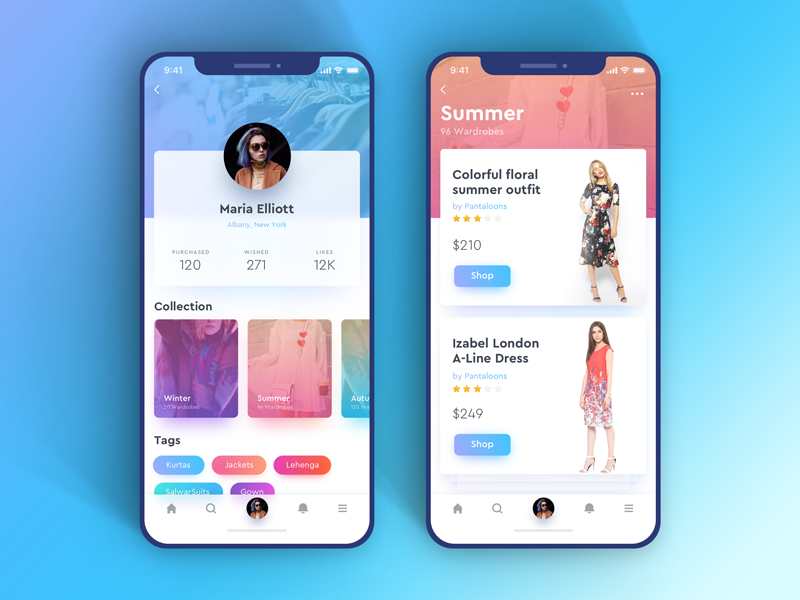Follow these 7 steps for creating a bulletproof UI/ UX strategy

Just how significant is your website design? In a survey, when users were asked to describe the reason why they didn’t trust a website, 94% of the comments indicated problems with the website’s design.
In today’s aggressive marketplace abounding with all-too-similar offerings, it’s easy to notice how a deliverable focused on good UI/ UX can become a vital competitive differentiator.

Every $1 invested in UX brings between $2 and $100 in return. (Source)
To prove this point, over the years, a plethora of reputed business organizations have indicated a positive ROI of investing in UX. Companies like Apple, Google, Airbnb, Uber, Mint, etc. owe a greater part of their success to their user-centric design strategy that culminates into incredible user experiences.
7 Steps to Create a Powerful UI/ UX Strategy
The first step to ensure the success of every business venture is to create a powerful and operative strategy. This strategy is what guides the different stages of operation and facilitates the decision-making process.
Whether it is a mobile app or a website, without a solid UI/ UX strategy, the design is most likely to lack elements, features, and overall usability that make it popular among the users.
While the idea of creating a UI/ UX strategy might sound that like a monotonous exercise, it might turn out to be a highly fruitful practice for your project. In this article, we will talk about the different steps that you must take to create a powerful strategy for a successful mobile app.
-
Start with understanding what a UI/ UX strategy is
Before you set out to prepare a robust UI/ UX strategy, you need to know what it really entails.
To begin with, it is important to understand that a UI/ UX strategy is different from UI/ UX design. This strategy should be the starting point, much before the designing or development of a digital product begins. In other words, it is the vision of a product that needs to be validated with the real customers to ensure that it is desired in the market. It is like a well-laid-out plan to achieve the specific business goals under conditions of ambiguity.
To differentiate between UI/ UX strategy and UI/ UX design in a more comprehensive manner, we can say that a design is concerned with making the product usable and interactive whereas the strategy focuses on the direction of the product and accomplishing business goals.
So, the best way to go ahead with your UI/ UX strategy should be well-aligned with your business objectives and common user interface and user experience trends.
-
Conduct a thorough research
Formulating a strong UI/ UX strategy requires a great deal of research. You need to interact with different groups of people to understand the needs and expectations of your target customers. To begin with, there are three sets of people who are associated with your mobile app.
- Primary stakeholders: These are the top tier people of the business organization who are in charge of all the decisions. These people have generally a lot to say about the app and thus, they must be involved in the process from the very start. Ask them for their feedback and the metrics they wish to track.
- Secondary stakeholders: These are the individuals who are related to the company but not a part of the project development team. For instance, general employees, financial investors, etc. fall under this category. You must ask about the needs of the secondary stakeholders and understand their purpose behind using the app.
- Users: Prospective users are the most important people who are going to interact with your app. You can conduct surveys to know more about these users and find out about the type of features and functionalities they would like to see in the app.
Apart from this, you must also look at the competition in the market. You need to devise ways to offer a website experience that the real users are looking for. Make sure that your app is unique enough to draw customers and isn’t just a duplication of what’s already there.
-
Layout the app design
Once you have thoroughly surveyed the market and your competitors, you have got a fair idea of what the users want from your app. Based on the outcomes of your research, it is easy to start sketching and designing the product.

At this stage, your app designing team will plan out a set of wireframes for feedback. Try to map the path of user experience throughout the design. See how the users will engage with the app and define the metrics needed to measure the results.
Remember this process can be very extensive with a myriad of versions going out for feedback before one single design is finalized.
-
Test the UI and UX
Testing is perhaps the most important phase in the development of a digital product. Will the users visit your app? Will they perform as you expect them to? Will they have a smooth user journey through the app? These are some questions that can only be answered after testing.
This is the reason why most of the app developers launch a beta version before releasing the final app. Knowing the app is in a testing phase can alter the expectations of the users. So, make sure to put out a beta version to collect important user feedback. By launching this, the developers can understand whether the app’s UI and UX is satisfactory. It is a significant step in creating a bulletproof UI/ UX strategy as it makes you better equipped about the demands of the users.
-
Appraise the test results
After testing, it is time to look at all the data that has been collected so far. Remember, gathering data is no good unless you put it to use.
Find out the components of the app design that are making the users happy. You can find this out by checking the pages where users are spending maximum time. Compare these elements to those that are not working. Evaluate the difference and try to take those principles and apply them comprehensively across the entire design.
Closely assess the pages that are not working. These will be the ones where the users are spending the least time. Try to identify the issues so that adjustments can be made.
-
Revise the design and release a new version
After all the assessment and evaluation, it is time to take action. Make the necessary amendments to the design to enhance the user’s journey. Remember even the smallest of change can cast a huge difference.
Release the new version and test again.
This is an ongoing process to improve the user experience and offer them the best. A lot of times, the changes you do may not even be perceptible yet if they add to the user journey, they must be incorporated.
-
Stay updated
Generally, most app developers believe that their job is done once they have satisfied the users with their app design. However, this is not the right approach.
The best user experiences seldom stop evolving. Owing to the rapidly progressing technology, trends keep on changing. So, in order to make the most of your app and keep your users satisfied, you need to stay on top of the evolving trends.
Constantly incorporating the latest technology into your app will not just keep your users engaged but also ensure that your app does not vitiate with time.
Conclusion
Having a solid UI/ UX strategy is inevitable to the success of every digital product. Simply developing an app and throwing it on the internet is an extremely dangerous idea that is not at all recommended.
Just as every business needs a well-laid-out plan, every mobile app requires a good and effective UI/ UX strategy to satisfy the users and stay relevant.
Author Bio:
 James Grills is currently associated with Cumulations Technologies, a leading Mobile App development company in India. He is a technical writer with a passion for writing on emerging technologies in the areas of mobile application development and IoT technology.
James Grills is currently associated with Cumulations Technologies, a leading Mobile App development company in India. He is a technical writer with a passion for writing on emerging technologies in the areas of mobile application development and IoT technology.






